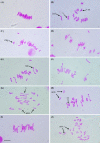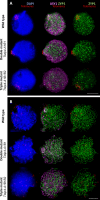ZIP4 is required for normal progression of synapsis and for over 95% of crossovers in wheat meiosis
- PMID: 37324713
- PMCID: PMC10266424
- DOI: 10.3389/fpls.2023.1189998
ZIP4 is required for normal progression of synapsis and for over 95% of crossovers in wheat meiosis
Abstract
Tetraploid (AABB) and hexaploid (AABBDD) wheat have multiple sets of similar chromosomes, with successful meiosis and preservation of fertility relying on synapsis and crossover (CO) formation only taking place between homologous chromosomes. In hexaploid wheat, the major meiotic gene TaZIP4-B2 (Ph1) on chromosome 5B, promotes CO formation between homologous chromosomes, whilst suppressing COs between homeologous (related) chromosomes. In other species, ZIP4 mutations eliminate approximately 85% of COs, consistent with loss of the class I CO pathway. Tetraploid wheat has three ZIP4 copies: TtZIP4-A1 on chromosome 3A, TtZIP4-B1 on 3B and TtZIP4-B2 on 5B. Here, we have developed single, double and triple zip4 TILLING mutants and a CRISPR Ttzip4-B2 mutant, to determine the effect of ZIP4 genes on synapsis and CO formation in the tetraploid wheat cultivar 'Kronos'. We show that disruption of two ZIP4 gene copies in Ttzip4-A1B1 double mutants, results in a 76-78% reduction in COs when compared to wild-type plants. Moreover, when all three copies are disrupted in Ttzip4-A1B1B2 triple mutants, COs are reduced by over 95%, suggesting that the TtZIP4-B2 copy may also affect class II COs. If this is the case, the class I and class II CO pathways may be interlinked in wheat. When ZIP4 duplicated and diverged from chromosome 3B on wheat polyploidization, the new 5B copy, TaZIP4-B2, could have acquired an additional function to stabilize both CO pathways. In tetraploid plants deficient in all three ZIP4 copies, synapsis is delayed and does not complete, consistent with our previous studies in hexaploid wheat, when a similar delay in synapsis was observed in a 59.3 Mb deletion mutant, ph1b, encompassing the TaZIP4-B2 gene on chromosome 5B. These findings confirm the requirement of ZIP4-B2 for efficient synapsis, and suggest that TtZIP4 genes have a stronger effect on synapsis than previously described in Arabidopsis and rice. Thus, ZIP4-B2 in wheat accounts for the two major phenotypes reported for Ph1, promotion of homologous synapsis and suppression of homeologous COs.
Keywords: Ph1; Triticum turgidum; ZIP4; crossover; meiosis; synapsis; tetraploid wheat.
Copyright © 2023 Draeger, Rey, Hayta, Smedley, Alabdullah, Moore and Martín.
Conflict of interest statement
The authors declare that the research was conducted in the absence of any commercial or financial relationships that could be construed as a potential conflict of interest.
Figures



Similar articles
-
A separation-of-function ZIP4 wheat mutant allows crossover between related chromosomes and is meiotically stable.Sci Rep. 2021 Nov 8;11(1):21811. doi: 10.1038/s41598-021-01379-z. Sci Rep. 2021. PMID: 34750469 Free PMC article.
-
A Duplicated Copy of the Meiotic Gene ZIP4 Preserves up to 50% Pollen Viability and Grain Number in Polyploid Wheat.Biology (Basel). 2021 Apr 2;10(4):290. doi: 10.3390/biology10040290. Biology (Basel). 2021. PMID: 33918149 Free PMC article.
-
Magnesium Increases Homoeologous Crossover Frequency During Meiosis in ZIP4 (Ph1 Gene) Mutant Wheat-Wild Relative Hybrids.Front Plant Sci. 2018 Apr 20;9:509. doi: 10.3389/fpls.2018.00509. eCollection 2018. Front Plant Sci. 2018. PMID: 29731763 Free PMC article.
-
Unravelling mechanisms that govern meiotic crossover formation in wheat.Biochem Soc Trans. 2022 Aug 31;50(4):1179-1186. doi: 10.1042/BST20220405. Biochem Soc Trans. 2022. PMID: 35901450 Free PMC article. Review.
-
Meiotic chromosome structure and function in plants.Cytogenet Genome Res. 2014;143(1-3):6-17. doi: 10.1159/000365260. Epub 2014 Jul 30. Cytogenet Genome Res. 2014. PMID: 25096046 Review.
Cited by
-
DMC1 stabilizes crossovers at high and low temperatures during wheat meiosis.Front Plant Sci. 2023 Aug 8;14:1208285. doi: 10.3389/fpls.2023.1208285. eCollection 2023. Front Plant Sci. 2023. PMID: 37615022 Free PMC article.
-
Past innovations and future possibilities in plant chromosome engineering.Plant Biotechnol J. 2025 Mar;23(3):695-708. doi: 10.1111/pbi.14530. Epub 2024 Nov 29. Plant Biotechnol J. 2025. PMID: 39612312 Free PMC article. Review.
References
-
- Alabdullah A.-K., Borrill P., Martín A. C., Ramírez-González R. H., Hassani-Pak K., Uauy C., et al. . (2019). A co-expression network in hexaploid wheat reveals mostly balanced expression and lack of significant gene loss of homeologous meiotic genes upon polyploidization. Front. Plant Sci. 10, 1325. doi: 10.3389/fpls.2019.01325 - DOI - PMC - PubMed
-
- Anderson L. K., Lohmiller L. D., Tang X., Hammond D. B., Javernick L., Shearer L., et al. . (2014). Combined fluorescent and electron microscopic imaging unveils the specific properties of two classes of meiotic crossovers. Proc. Natl. Acad. Sci. U.S.A. 111, 13415–13420. doi: 10.1073/pnas.1406846111 - DOI - PMC - PubMed
LinkOut - more resources
Full Text Sources
Research Materials
Miscellaneous

